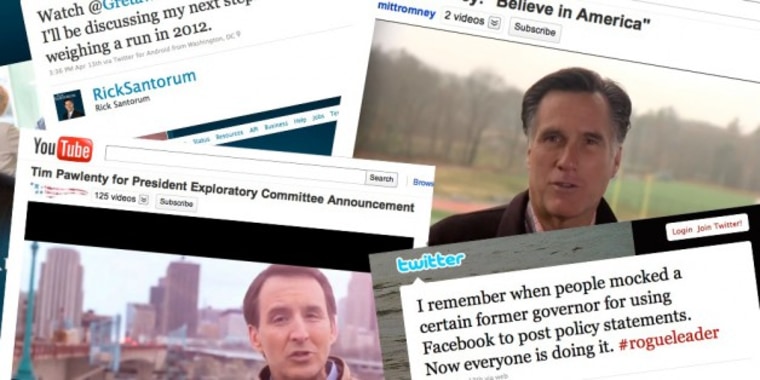On February 13, 2007, former Massachusetts Gov. Mitt Romney stood at the Henry Ford Museum in Dearborn, Mich. to declare his presidential intentions against a powerful backdrop of legacy and innovation. Four years later, his announcement of relatively the same caliber was reduced to 140 Twitter characters and a 150-second video post.
The shift is pervasive. Of the potential presidential candidates who have officially announced either an exploratory committee or a “testing the waters” effort, former House Speaker Newt Gingrich toed the most conventional line with a brief press conference last month.
Former Gov. Tim Pawlenty made his announcement in a Facebook video; former Sen. Rick Santorum’s came on a Fox News interview; Herman Cain posted a statement to his website; President Obama e-mailed supporters, accompanied by a video.
On cue, a Tweet last week by Rebecca Mansour—cyber-messenger for former Alaska Gov. Sarah Palin, a potential White House contender herself—bragged: “I remember when people mocked a certain former governor for using Facebook to post policy statements. Now everyone is doing it. #rogueleader.”
As candidates scramble to embrace communication methods worthy of Generation Y, have the traditional balloons and bunting fallen by the wayside?
Zac Moffatt, online director for team Romney, doesn’t think so—the uptick in social media tendencies, he said, are merely “a reflection of where things are; I don’t think it’ll ever replace [traditional campaign methods]. People have been saying mail will be gone for the past 50 years, and obviously we have yet to see that happen.”
Pawlenty spokesman Alex Conant agrees. “New media has a way to supplement traditional hand-shaking and in-person meetings that are so crucial to this process,” he said. “It offers another way to answer voters’ questions and get out messages, but no candidate can hope to win in Iowa or New Hampshire or anywhere without physically campaigning, and campaigning hard.”
New media isn’t all that new to presidential campaigns: Four years ago, Democratic contenders Obama and Hillary Clinton both announced exploratory committees with YouTube videos. Obama was an aggressive adopter of the Internet as a bully pulpit for campaign messages. And when he announced his vice presidential pick in 2008, he did it with a text message—a pre-advertised gambit that not-so-coincidentally enabled him to harvest valuable cell phone numbers of potential supporters.
This year’s candidates are elaborating on the new media theme. Indeed, prolonging campaign announcements via every available form of technology seems to be the hallmark of the 2012 campaign. Before Romney posted his YouTube video, he Tweeted his intention to do so; prior to Santorum’s Fox News interview, he teased a “major announcement” in an e-mail and on Twitter; now, Donald Trump has said that on next month’s season finale of his reality TV show The Apprentice, he’ll announce not whether or not he’s going to run, but when he’s going to make that announcement.
“Some of these guys want to make it a soap opera—’Will I or won’t I?’ ” said Robert Thompson, a professor of popular culture at Syracuse University. “They’re prolonging it the way Ryan Seacrest prolongs who got voted off on American Idol, because they’ve got one big piece of information that’s the cliffhanger, and if they string it along, presumably they’ll get people interested and aggregate a larger base of followers.”
Joan McCarter, senior policy editor of the progressive blog Daily Kos, said the “Palin effect,” coupled with an “Obama aspect,” is driving 2012 candidates to the web.
“Palin has really become a celebrity, and you have to ask how much of that is how accessible she is online,” she said. “Others now feel like it’s a bar that’s been set that they have to meet. Then Obama had this huge, huge Internet base, making a campaign that was almost larger than life. And now candidates are trying to figure out how to match that.”
The new media offers advantages for candidates too. “Social media is a conversation,” the Romney campaign’s Moffatt said. “It’s a two-way dialogue versus just one-way dialogue.” Because sites like Twitter and Facebook allow users to accumulate “followers” and view comments, Moffatt continued, “it’s the perfect way to gauge support in that exploratory phase. There’s just such a finite amount of time and places where someone can be, and that’s where digital comes in.”
Thompson, though, said fans of the old-school style of politicking will get their rallies eventually. “All these new technologies have value, especially in the first act of a candidacy,” he said. “It allows them to put their feelers out before they can afford to buy balloons and bunting. But eventually, they will need to move into act two.
“Of course, they’ll continue to use social media—it’s a given,” Thompson continued. “But some people have argued that a person can get elected on a solely Internet campaign. I don’t think that’s true, nor will it probably ever be.”
The article, "Candidates Vie to Star in 'The Social Network,' 2012 Edition" first appeared in the National Journal.
